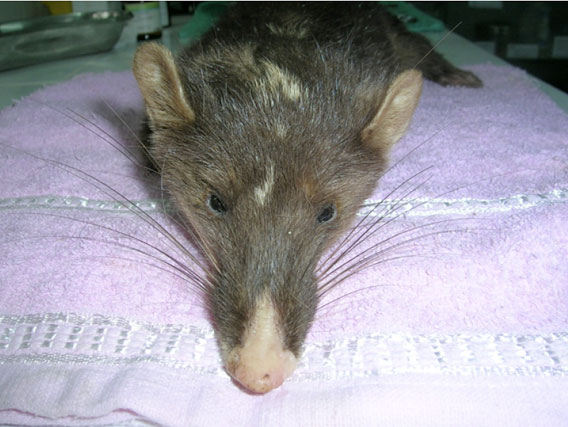
Photo of first individual of new ferret-badger species that died in cage. Photo by: Elke Schwierz.
A new species of omnivorous mammal has been found in Cuc Phuong National Park, Vietnam. A part of the weasel family, the new species is known as a ferret-badger, a strange subfamily of mammals that have been little-studied by researchers. Smaller than proper badgers, ferret-badgers have elongated faces and long bushy tails.
Described in Der Zoologische Garten, researchers named the new species after its place-of-origin: the Cuc Phuong ferret-badger (Melogale cucphuogensis). The new mammal was first discovered in 2005 after rangers found it wounded from a snare. A vet with the Endangered Primate Rescue Center amputated the animal’s leg to save it, but unfortunately the wild animal accidently strangled-itself in a cage wire. Its body was not preserved. Then in 2006, a recently dead individual was discovered, allowing researchers to describe it. The new species is the fifth ferret badger known and inhabits an area also home to two others: the Chinese ferret-badger (Melogale moschata) and the Burmese ferret-badger (Melogale personata).
“Hardly any information on their biology and ecology is available,” the authors write. “There is even less information available about their habitat requirements or ecological niches, and therefore coexistence and/or competition of these species.”
The IUCN Red List has only been able to evaluate the Chinese ferret-badger (listed as Least Concern), while the others are considered Data Deficient. The Chinese ferret-badger has been the most researched. It is nocturnal and spends much of its time underground. It feeds on a wide-range of prey including earthworms, insects, molluscs, frogs, carrion, eggs, and even fruit.
While the discovery of new species is not uncommon—researchers documented over 18,225 new species in 2008 alone—finding new mammals is rare. In 2008, only 41 new species discovered were mammals (less than half a percent). Finding a new non-rodent mammal is even more astounding: a third of the new mammals recorded were rodents in 2008.
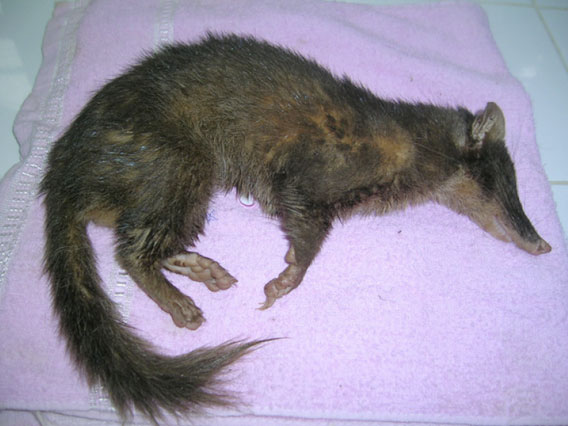
Side view of new mammal. Photo by: Elke Schwierz.
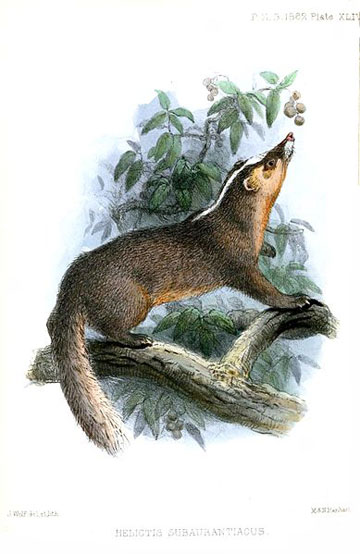
Illustration of the Chinese ferret-badger from 1862. Illustration by: Joseph Wolf.
CITATION: Tilo Nadler, Ulrike Streicher, Clara Stefen, Elke Schwierz, Christian Roos. A new species of ferret-badger, Genus Melogale,
from Vietnam. Der Zoologische Garten. 80 (2011) 271–286.
Related articles
Photos: two dozen new beetles discovered in Papua New Guinea hotspot
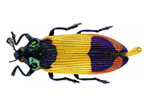
(11/23/2011) Over the past two decades, at least 24 new beetles species have been discovered in a remote mountainous rainforest region of Papua New Guinea by Swedish entomologists Ulf Nylander. Described in the new book Biodiversity, Biogeography and Nature Conservation in Wallacea and New Guinea, the new beetles found in the Aseki Province are all ecologically linked to rotting wood.
One night only: new orchid species surprises scientists
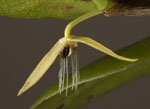
(11/22/2011) A mysterious new orchid blooms for one night only, opening around 10 PM and closing at 10 AM. Discovered on the island of New Britain near Papua New Guinea, the new species is the world’s first orchid that flowers only at night. Scientists found the new flower, named Bulbophyllum nocturnum, in a logging concession on the tropical island.
Photos: bizarre shell of new snail baffles researchers

(11/10/2011) A new species of snail with a bizarre shell has surprised scientists. Discovered near massive waterfalls in pristine lowland rainforest in New Guinea, the tiny new species’ shell is shaped like a cornucopia, spirals flying freely instead of fused together like most shells. Latvian malacologist (one who study molluscs) Kristine Greke, who described the new species, named it Ditropopsis mirabilis, meaning miraculous or extraordinary. To date, scientists are uncertain why the super small snail—2 to 6 millimeters (0.07 to 0.23 inches)—would have evolved such a strange shell.
If camera traps don’t prove existence of Bigfoot or Yeti nothing will

(10/13/2011) Let me state for the record that I am skeptical of the existence of Bigfoot or the Yeti, however I do have a fascination for following the latest news on the seemingly never-ending search for these hidden hominids. This week a Yeti conference in Russia announced ‘indisputable proof’ of the legendary hairy ape in the wilds of Southern Siberia. What did this proof consist of? Not DNA, photographs, video, or the Yeti itself (dead or alive) as one would expect from the word ‘indisputable’, but a few alleged Yeti hairs, an alleged bed, and alleged footprints. Cryptozoologists, those who are fascinated by hidden species such as the proposed Yeti and Bigfoot, don’t serve their cause by stating the reality of a species without the evidence long-deemed necessary by scientific community to prove it—either a body or DNA samples combined with clear photographic evidence—instead they make themselves easy targets of scorn and ridicule.
Meet the just discovered ‘Komodo dragon’ of wasps
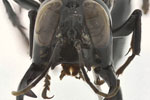
(08/28/2011) A new species of warrior wasp has been discovered on the Indonesian island of Sulawesi that is so large and, frankly, terrifying-looking that it has been dubbed the ‘Komodo dragon’ of the wasp family. Bizarrely, the male of the species has jaws that outstretch its limbs. “I don’t know how it can walk,” said the wasp’s discoverer, entomologist Lynn Kimsey of the University of California, Davis and director of the Bohart Museum of Entomology, in a press release. “Its jaws are so large that they wrap up either side of the head when closed.”
Humanity knows less than 15 percent of the world’s species

(08/23/2011) Scientists have named, cataloged, and described less than 2 million species in the past two and a half centuries, yet, according to an new innovative analysis, we are no-where near even a basic understanding of the diversity of life on this small blue planet. The study in PLoS Biology, which is likely to be controversial, predicts that there are 8.7 million species in the world, though the number could be as low as 7.4 or as high as 10 million. The research implies that about 86 percent of the world’s species have still yet to be described.
New species is eel-equivalent of the coelacanth
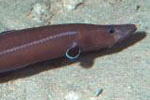
(08/18/2011) The ocean holds endless surprises still. In an underwater cave off the Pacific island nation of Palau, reachers have made an astounding discovery: an eel species unknown to science that harkens back 200 million years. The species, described in the Proceedings of the Royal Society B as an ‘enigmatic, small eel-like fish’, sports anatomical features that differentiate it from the over 800 known species of eel surviving today.
2-4 new shrew species discovered in Sulawesi
(06/28/2011) A research expedition has turned up two to four new species of shrew on the Indonesian island of Sulawesi, reports a conservation group working to protect their forest habitat.
Pictures: Turquoise ‘dragon’ among 1,000 new species discovered in New Guinea
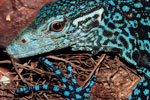
(06/27/2011) Scientists discovered more than 1,000 previously unknown species during a decade of research in New Guinea, says a new report from WWF. While the majority of 1,060 species listed are plants and insects, the inventory includes 134 amphibians, 71 fish, 43 reptiles, 12 mammals, and 2 birds. Among the most notable finds: a woolly giant rat, an endemic subspecies of the silky cuscus, a snub-fin dolphin, a turquoise and black ‘dragon’ or monitor lizard, and an 8-foot (2.5-m) river shark.
Photos: 600 new species discovered in Madagascar since 1999
(06/06/2011) More than 600 species of plants and animals have been described in Madagascar over the past decade, reiterating the position of Indian Ocean island as one of the world’s top biodiversity hotspots, says a new report issued today by WWF.
The saola: rushing to save the most ‘spectacular zoological discovery’ of the 20th Century
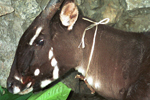
(04/04/2011) The saola (Pseudoryx nghetinhensis) may be the most enigmatic, beautiful, and endangered big mammal in the world—that no one has ever heard of. The shy ungulate looks like an African antelope—perhaps inhabiting the wide deserts of the Sahara—but instead it lives in the dense jungles of Vietnam and Laos, and is more related to wild cattle than Africa’s antelopes. The saola is so unusual that is has been given its own genus: Pseudoryx, due to its superficial similarities to Africa’s oryx. In the company of humans this quiet forest dweller acts calm and tame, but has yet to survive captivity long. Yet strangest of all, the 200 pound (90 kilogram) animal remained wholly unknown to science until 1992.